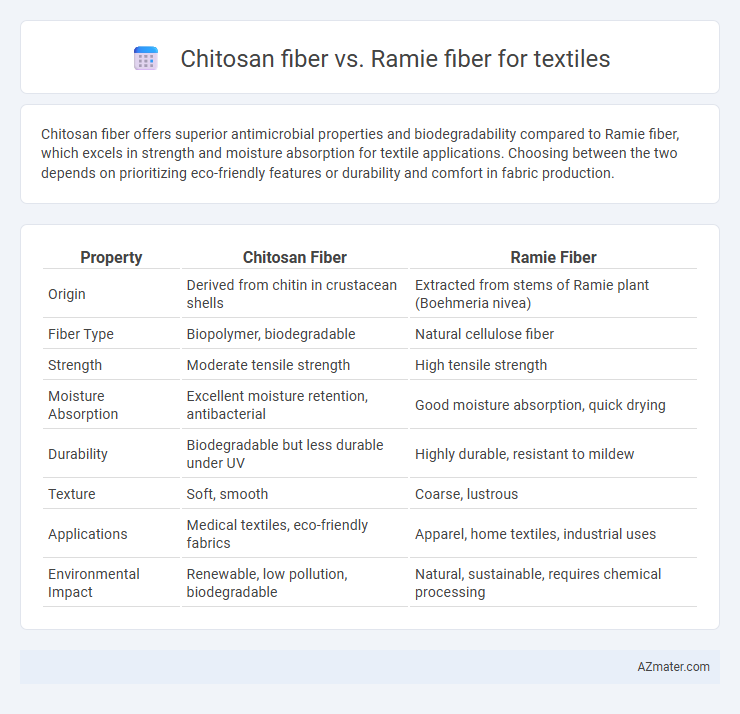Chitosan fiber offers superior antimicrobial properties and biodegradability compared to Ramie fiber, which excels in strength and moisture absorption for textile applications. Choosing between the two depends on prioritizing eco-friendly features or durability and comfort in fabric production.
Table of Comparison
| Property | Chitosan Fiber | Ramie Fiber |
|---|---|---|
| Origin | Derived from chitin in crustacean shells | Extracted from stems of Ramie plant (Boehmeria nivea) |
| Fiber Type | Biopolymer, biodegradable | Natural cellulose fiber |
| Strength | Moderate tensile strength | High tensile strength |
| Moisture Absorption | Excellent moisture retention, antibacterial | Good moisture absorption, quick drying |
| Durability | Biodegradable but less durable under UV | Highly durable, resistant to mildew |
| Texture | Soft, smooth | Coarse, lustrous |
| Applications | Medical textiles, eco-friendly fabrics | Apparel, home textiles, industrial uses |
| Environmental Impact | Renewable, low pollution, biodegradable | Natural, sustainable, requires chemical processing |
Introduction to Chitosan and Ramie Fibers
Chitosan fiber, derived from the deacetylation of chitin found in crustacean shells, offers natural antimicrobial properties and biodegradability, making it ideal for sustainable textile applications. Ramie fiber, obtained from the stalks of the Boehmeria plant, is praised for its exceptional strength, luster, and moisture absorption capabilities. Both fibers contribute to environmentally friendly textiles, with chitosan providing enhanced functionality and ramie delivering high durability and comfort.
Fiber Origins and Production Processes
Chitosan fiber originates from chitin, primarily extracted from the shells of crustaceans like shrimp and crabs, and undergoes a chemical process that converts chitin into chitosan before being spun into textile fibers. Ramie fiber is derived from the stalks of the Ramie plant (Boehmeria nivea), involving mechanical decortication, degumming, and cleaning to separate the natural cellulose fibers. The production of chitosan fiber relies heavily on biopolymer technology and chemical modifications, while ramie fiber production is largely mechanical and related to plant-based fiber extraction methods.
Chemical Structure and Composition
Chitosan fiber is derived from chitin, composed primarily of D-glucosamine and N-acetyl-D-glucosamine units, featuring abundant amino groups that provide excellent antimicrobial properties and biodegradability. Ramie fiber, extracted from the stalks of the Boehmeria plant, is mainly cellulose, rich in glucose units linked by b-1,4-glycosidic bonds, offering high tensile strength and luster due to its crystalline structure. The chemical differences result in chitosan fibers possessing functional reactive sites for biomedical applications, while ramie fibers excel in durability and moisture absorption for textile uses.
Physical and Mechanical Properties
Chitosan fiber exhibits excellent antimicrobial properties, superior moisture absorption, and enhanced biodegradability compared to ramie fiber, making it ideal for functional textiles. Ramie fiber offers higher tensile strength, better wrinkle resistance, and greater durability, which supports its widespread use in traditional fabric production. The combination of chitosan's bioactivity with ramie's mechanical robustness creates opportunities for innovative textile applications requiring both performance and sustainability.
Biodegradability and Environmental Impact
Chitosan fiber, derived from chitin found in crustacean shells, exhibits excellent biodegradability, breaking down naturally in soil and aquatic environments within weeks, reducing long-term environmental impact. Ramie fiber, a natural bast fiber from the Boehmeria plant, is also biodegradable but decomposes slower than chitosan, requiring more time to return nutrients to the soil. Both fibers are sustainable alternatives to synthetic textiles, with chitosan offering enhanced antimicrobial properties and faster degradation, making it a greener choice for eco-friendly textile applications.
Moisture Absorption and Breathability
Chitosan fiber exhibits superior moisture absorption due to its hydrophilic amino groups, enabling efficient sweat management and high breathability in textile applications. Ramie fiber, while naturally breathable with good moisture wicking properties, has lower water absorption capacity compared to chitosan, making it less effective in high-humidity environments. The antimicrobial properties of chitosan further enhance fabric comfort by reducing odor and bacterial growth, giving it an edge over ramie in performance textiles.
Dye Affinity and Color Fastness
Chitosan fiber exhibits superior dye affinity due to its amino groups that enhance bonding with acid and reactive dyes, resulting in more vibrant and uniform coloration compared to ramie fiber. Ramie, a bast fiber, demonstrates moderate dye uptake but often requires mordants to improve color fastness, which may lead to environmental concerns. Chitosan fibers also show better color fastness to washing and light exposure, making them preferable for textiles requiring durable and long-lasting hues.
Antimicrobial and Functional Properties
Chitosan fibers exhibit strong antimicrobial properties due to their natural polycationic structure, effectively inhibiting the growth of bacteria and fungi, making them highly suitable for medical textiles and hygiene products. Ramie fibers, while known for durability and moisture absorption, possess limited inherent antimicrobial activity and usually require chemical treatments to enhance functionality. The functional advantages of chitosan fibers include biodegradability, biocompatibility, and wound healing capabilities, whereas ramie fibers excel in mechanical strength and breathability but lack the intrinsic antimicrobial benefits of chitosan.
Applications in Textile Industry
Chitosan fiber exhibits excellent antibacterial properties and biodegradability, making it ideal for medical textiles, sportswear, and hygiene products. Ramie fiber, known for its strength, luster, and moisture absorption, is widely used in apparel, upholstery, and industrial textiles. Both fibers serve sustainable textile applications, with chitosan enhancing functional performance and ramie providing durability and comfort.
Comparative Advantages and Limitations
Chitosan fiber exhibits superior antibacterial and biodegradability properties, making it ideal for medical and hygiene textiles, whereas Ramie fiber is valued for its natural luster, high tensile strength, and moisture absorbency, enhancing comfort and durability in apparel. Chitosan fiber's limitations include higher production costs and lower mechanical strength compared to Ramie, which can suffer from stiffness and poor elasticity, restricting its use in stretchable fabrics. Both fibers offer eco-friendly alternatives, with Ramie excelling in strength and moisture management, while Chitosan provides functional benefits like antimicrobial activity and environmental compatibility.

Infographic: Chitosan fiber vs Ramie fiber for Textile
 azmater.com
azmater.com